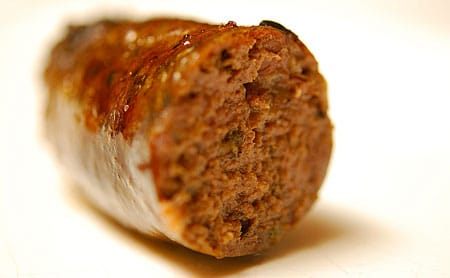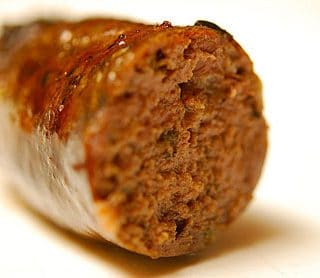Duck Sausages, Hunter’s Style
April 18, 2015 | Updated October 28, 2020
As an Amazon Associate I earn from qualifying purchases.

When life gives you lots of ducks or geese (this happens a lot with snow goose hunters), you should make duck sausage, or goose sausage, out of them. Use the shot-up birds you won’t feel bad about cutting up; save the perfect birds for roasting or other uses.
Other than snow geese, Canada geese, spoonies, diver or sea ducks are excellent candidates for sausage. I wouldn’t do this with nice pintails, mallards or wood ducks, though.
This sausage is “hunter’s style,” which to me means coarsely ground and flavored with traditional European game spices, such as caraway, juniper and sage. This duck sausage has all three, with sage as its main herb.
Juniper and caraway can sometimes be hard to find, although every major supermarket I’ve every been to has at least caraway. Juniper can be tougher to source, but if you live in the West there are a lot of wild species of juniper; the best is Juniperus communis. In the East, look for the blue berries on Eastern Red Cedar, Juniperus virginiana. You can buy juniper in fancy supermarkets, in places like Cost Plus World Market, and online through places like Penzey’s.
Once made, these will keep a week in the fridge, and can be frozen.
New to making sausage? You can find my detailed tutorial on how to make sausages at home here.
Duck Sausages, Hunter's Style
Ingredients
- 3 1/2 pounds duck or goose meat
- 1 1/2 pounds fatty pork shoulder or pork belly
- 34 grams kosher salt, about 2 level tablespoons
- 2 tablespoons chopped fresh sage
- 1 tablespoon ground black pepper
- 2 teaspoons caraway seed
- 2 teaspoons mashed and chopped juniper berries, about 10 berries (optional)
- 1/4 cup ice water
- 1/4 cup dark, malty beer, chilled
- hog casings
Instructions
- Get out about 15 feet of hog casings and soak them in warm water. If you don’t trust your source, run water through them to check for punctures or weak spots.
- Make sure all your equipment is cold; freeze your grinder’s grinding plate and blades, and the bowl you will put the meat into for 30 minutes to an hour. Do the same for the meat and fat. When everything’s nice and cold, mix the meat and fat with the salt and all the dry spices.
- Grind it all through a very coarse plate; I use a 10 mm plate. Test the temperature of the mixture, and if it’s 35°F or colder, go ahead and grind it all again through a coarser die, like a 6 mm or thereabouts. If it’s warmer, put the mix back in the freezer to chill until it hits 35°F or cooler. (if you don't have a very coarse plate, grind half the mixture a second time through the finer, typically 4.5 mm plate. It's important to grind the meat twice.)
- Once the sausage has been ground twice, test the temperature again to make sure it’s cold. I prefer to chill the mix down to 28°F to 32°F for this next stage. Chill the mix and when it’s cold enough, take it out and add the beer and water. Now, mix and knead the mixture in a big bin or bowl with your hands for a solid 2 minutes — your hands will ache with cold, which is good. You want everything to almost emulsify.
- Stuff the sausage into the casings rather loosely into a continuous coil. When you're done, it's time to make links. I like my sausages to be about 6 to 8 inches long, but it’s your choice. To twist them into links, tie off one end of the coil you just made. Pinch off links with your two hands and roll the link between them forward a couple times. Move down the coil and repeat, only this time roll backwards a few times. Repeat until you do the whole coil. (Here is a video showing how I do it.) Now look at the links, which will probably have air pockets in them. Use a sterile needle or sausage pricker (set it aglow in your stovetop flame) to puncture the casing over all the air pockets. Gently compress the links together to squeeze out the air pockets and rotate the links a bit more to tighten; this takes practice.
- Hang your links for at least 1 hour if your room is warm, and up to overnight if you can hang them in a place that’s 40°F or cooler. Don’t let them freeze yet. If you are not hanging overnight, let the sausages continue to dry uncovered in the fridge overnight before you seal them up and freeze. These sausages will keep a week in the fridge and a year in the freezer, if you have vacuum-sealed them.
Notes
Nutrition
Nutrition information is automatically calculated, so should only be used as an approximation.





Hey Hank,
How do you hang the sausages without them coming unwound?
Cheers,
Kyle
Kyle: On a clothes drying rack. When you make the links, rolling them in opposite directions, e.g., one link rolled away from you, the next link rolled toward you, helps a lot.
Hello Hank, two quick questions for you. First, do you like the meat chilled for sanitary reasons, or is it just easier to work with? Second, could I sous vide before freezing to use as a fully cooked sausage? Thanks for another great recipe!
Bryce: The meat needs to be chilled for sanitary reasons, but moreso to avoid “smear,” which is where the fat in the mix partially melts and smears over the meat in the mix. This destroys the bind you need for a good sausage.
I had some shovelers last year that were far too gamey for my taste, even after a rice heavy diet. And even mallard is a little gamey for my wife’s taste. I had a few other hunters recommend a soak in buttermilk or brine to draw out some of the blood/iron from the meat, which reduces the gamey flavor. Most of what I will be shooting this weekend will be mallards, gadwalls, teal, and maybe woodies.
John: Ah, the dreaded shovito. Yep, an overnight soak in buttermilk will do the trick. Rinse the meat off before grinding.
Hello, I am interested in trying this recipe, but have a question regarding “bleeding” the duck meat a bit before processing into sausage. I have heard buttermilk takes some of the gamey flavor out; could the duck be soaked in buttermilk before proceeding with this recipe? Or would the buttermilk spoil somehow in the sausage. Alternatively, if I wanted to soak the duck meat in saltwater before hand, how should I adjust the salt in the recipe?
John: Why would you soak duck meat? I rarely do, but it depends on the species. What sort of ducks are you using?
I tried this recipe using Canada Goose breasts. I measured out salt (34 g/3.5 pounds meat), and the sausages came out a bit too salty. Next time I try this, I will cut the salt in half.
Chris: Seriously? You thought 34 grams was too much salt for 5 pounds of sausage? (It’s not 3.5, as you mention in your note. You need to factor in the fat.) Interesting. You must be very, very sensitive to salt, as this is only 1.5 percent salt by weight. Don’t halve the salt next time. Don’t drop it lower than 22 grams, which is about 1 percent salt.
I made this recipe and replaced the duck with pheasant from this past fall. I added the optional chinese five spice powder and it was a little overpowering for my taste. I would opt to leave it out next time, but that is just personal preference.
Can you smoke, let cool, then freeze these sausages ? Or is it recommended to put straight to freezer and fully cook when thawed later?
Clint: Yes, that’s how I do it.
Abby, I just made this sausage and am also allergic to pork, I used the skin from the duck to substitute for the porl fat and it cooks up beautifully.
Hello! My son is allergic to beef and pork so we started raising our own meat chickens, turkeys, quail, and just added some ducks to our flock. I’d love to try this recipe but is there any way I could substitute the pork fat for some other fat that is safe for my sonA, duck fat maybe?
Abby: Nope. Only other fat I can think of that might work here is lamb fat.
Hi great post here. The art of making food from scratch appeals to me and I hope to try out this recipe. Can I use my mum’s trusty old manual meat mincer? It seems to be the same thing with what Americans call meat grinder.
Can you use liquor instead of beer or wine? Thanks for the info. Hard to find recipes with alcohol. I’m planning venison sausage, by the way. Also, do I need a cure?
Don: I wouldn’t. Too boozy. And you don’t need a cure in this case.
Bought the book and made this sausage without the casing. I rolled it into 1/2″ mini meatballs, browned them, and added to a soup I made with pesto tortellini, chicken broth and spinach. It was AWESOME!!!! Made another batch the next weekend it was so good.
have you ever made this recipe without stuffing the sausage in a casing? more liked pattied sausage? If so, how did it turn out?
I will be using frozen duck breasts to make my sausage. I want to refreeze the sausage. Any tips ?
Bill: When the sausages are made, either poach them in steaming water until cooked through to 160 degrees, or smoke them to this temperature. Then you can refreeze.
Hello M. Shaw
I would like to understand why it’s important to let the sausages dry? What’s happening chemistry wise?
regards
David
David: Not entirely sure, but I do know they tighten in their skins and the bind in the meat firms up. I suspect it is the salt denaturing proteins in the meat.
This looks wonderful, we have ducklings up to our ears right now. Any suggestion on substitution for beer *gluten free household) ?
Krystal: They make gluten free beers. If you can’t find them, just use water or wine.
Really excited to try this. Would there be any alterations to the recipie if I used muscovy ducks? We have a few that are headed to freezer camp this weekend and this seems like a good sausauge to do with them.
Leigh: It will work fine with Muscovy ducks.
I made this over the weekend and finally ate some up tonight (besides extra filling tossed in a pan during the stuffing process!). Pan seared the sausages, and tossed some sauerkraut in the pan at the end to deglaze a little. Probably the best way I’ve eaten black duck!
One question. The birds I used had been brined before I froze them months ago. I didn’t consider this, used the 34g salt to 5 lbs meat, and the sausage came out a little salty. Just use less salt next time?
Jared: Yep. That was the problem.
Yea Penzey’s!!!
I have one down the street from me. ????
Brilliant!